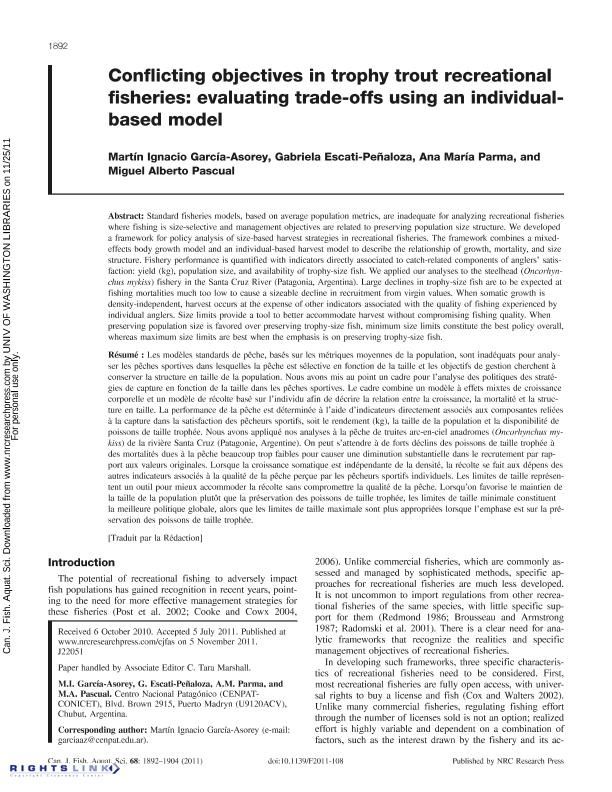Mostrar el registro sencillo del ítem
dc.contributor.author
Garcia Asorey, Martin Ignacio

dc.contributor.author
Escati Peñaloza, Gabriela

dc.contributor.author
Parma, Ana María

dc.contributor.author
Pascual, Miguel Alberto

dc.date.available
2022-11-02T05:35:15Z
dc.date.issued
2011-11
dc.identifier.citation
Garcia Asorey, Martin Ignacio; Escati Peñaloza, Gabriela; Parma, Ana María; Pascual, Miguel Alberto; Conflicting objectives in trophy trout recreational fisheries: evaluating trade-offs using an individual-based model; National Research Council Canada-NRC Research Press; Canadian Journal of Fisheries and Aquatic Sciences; 68; 11; 11-2011; 1892-1904
dc.identifier.issn
0706-652X
dc.identifier.uri
http://hdl.handle.net/11336/175909
dc.description.abstract
Standard fisheries models, based on average populations metrics are inadequate for analyzing recreational fisheries where fishing is size-selective and management objectives are related to preserving population size structure. Using data from the steelhead (Oncorhynchus mykiss) fishery in the Santa Cruz River (Patagonia, Argentina) we developed an individual-based harvest model to characterize the relationship between growth, mortality and size structure under different size-based harvest strategies. We evaluated fishery performance with indicators associated to catch-related components of anglers? satisfaction: yield (kg), population size, and availability of trophy-size fish. Large declines in trophy-size fish are to be expected at fishing mortalities much too light to cause a sizeable decline in recruitment from virgin values. When somatic growth is density independent, fish harvest occurs at the expense of other indicators associated to the quality of fishing experienced by individual anglers. Our results clearly expose such trade-offs, providing the kind of quantitative information managers need to decide where to operate. Size limits provide some tools to better accommodate harvest without compromising fishing quality. When preserving population size is favored over preserving trophy-size fish, minimum size limits constitute the best policies overall, whereas maximum size limits are best when the emphasis is on preserving trophy-size fish.
dc.format
application/pdf
dc.language.iso
eng
dc.publisher
National Research Council Canada-NRC Research Press

dc.rights
info:eu-repo/semantics/openAccess
dc.rights.uri
https://creativecommons.org/licenses/by-nc-sa/2.5/ar/
dc.subject
RECREATIONAL FISHERIES
dc.subject
MANAGEMENT OBJECTIVES
dc.subject
INDIVIDUAL-BASED MODEL
dc.subject
SIZE-SELECTIVE HARVEST
dc.subject.classification
Otros Tópicos Biológicos

dc.subject.classification
Ciencias Biológicas

dc.subject.classification
CIENCIAS NATURALES Y EXACTAS

dc.title
Conflicting objectives in trophy trout recreational fisheries: evaluating trade-offs using an individual-based model
dc.type
info:eu-repo/semantics/article
dc.type
info:ar-repo/semantics/artículo
dc.type
info:eu-repo/semantics/publishedVersion
dc.date.updated
2022-01-06T14:56:44Z
dc.journal.volume
68
dc.journal.number
11
dc.journal.pagination
1892-1904
dc.journal.pais
Canadá

dc.journal.ciudad
Otawa
dc.description.fil
Fil: Garcia Asorey, Martin Ignacio. Consejo Nacional de Investigaciones Científicas y Técnicas. Centro Nacional Patagónico; Argentina
dc.description.fil
Fil: Escati Peñaloza, Gabriela. Consejo Nacional de Investigaciones Científicas y Técnicas. Centro Nacional Patagónico; Argentina
dc.description.fil
Fil: Parma, Ana María. Consejo Nacional de Investigaciones Científicas y Técnicas. Centro Nacional Patagónico; Argentina
dc.description.fil
Fil: Pascual, Miguel Alberto. Consejo Nacional de Investigaciones Científicas y Técnicas. Centro Nacional Patagónico; Argentina
dc.journal.title
Canadian Journal of Fisheries and Aquatic Sciences

dc.relation.alternativeid
info:eu-repo/semantics/altIdentifier/url/https://cdnsciencepub.com/doi/10.1139/f2011-108
dc.relation.alternativeid
info:eu-repo/semantics/altIdentifier/doi/https://doi.org/10.1139/f2011-108
Archivos asociados
